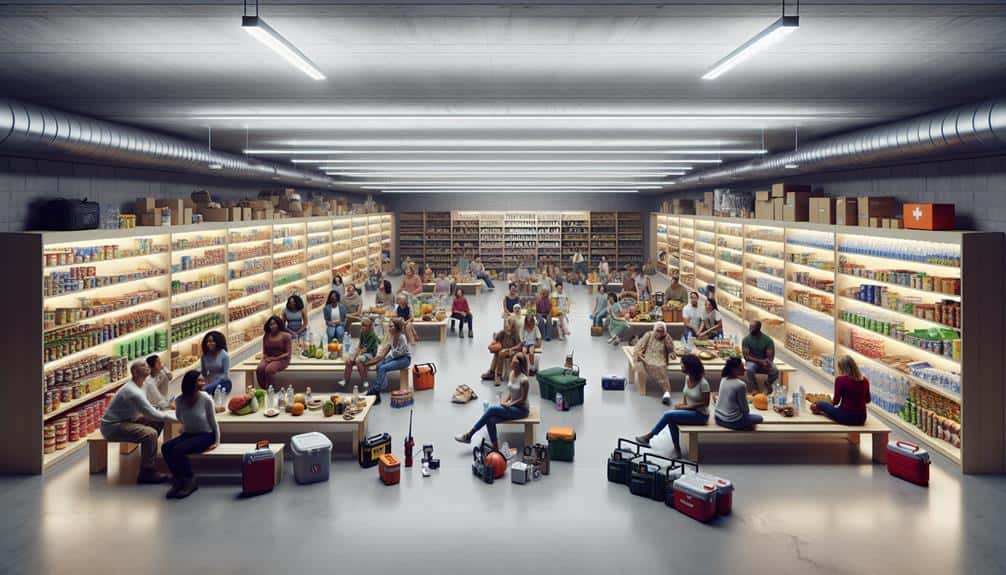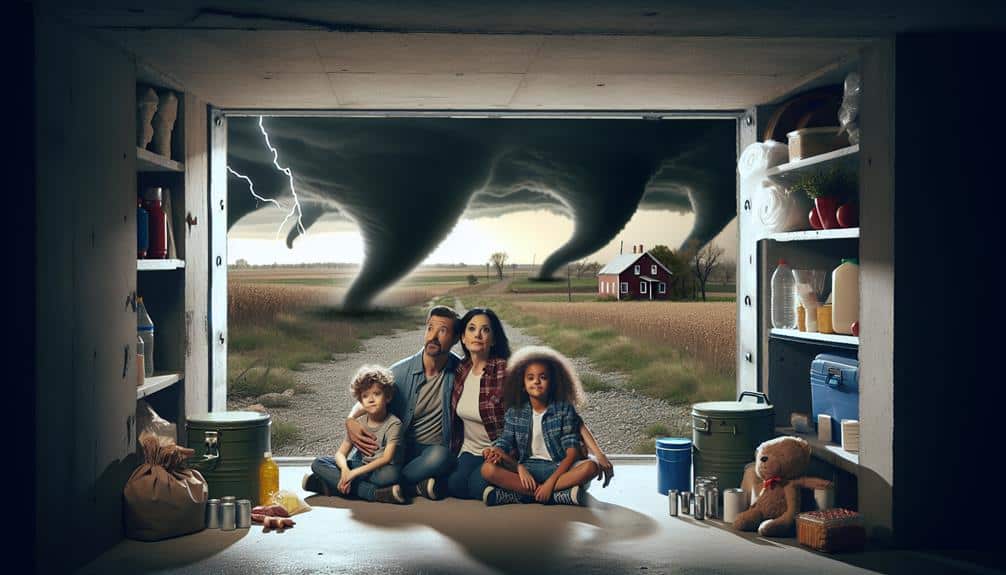We need to identify the best storm shelter locations with food storage, focusing on safety and practicality. Basement shelters offer secure, below-ground protection and are perfect for preserving non-perishables. Underground bunkers add superior defense against severe weather. Garage safe rooms maximize space with shelves and compartments for food. Backyard cellars guarantee air control for ideal storage conditions. Community shelters and schools provide ample storage and support through collective resources. Finally, large storm pods accommodate multiple families with robust supplies. For a more in-depth exploration into each option's specifics, stay with us as we examine how they serve both protection and sustenance needs.
Key Points
- Basement shelters offer secure, below-ground protection and ample space for non-perishable food storage.
- Underground bunkers provide the highest level of safety and ideal conditions for preserving emergency supplies.
- Garage safe rooms optimize space for food storage with shelves and hidden compartments.
- Backyard cellars feature shelving and climate control for effective food preservation and inventory management.
Basement Shelters
Why should we consider basement shelters as an ideal option for storm protection and food storage?
First and foremost, basement shelters offer impressive shelter safety. Located below ground level, they provide a sturdy refuge against high winds, flying debris, and even the potential havoc of tornadoes. The solid construction and earth surrounding them create a natural buffer, reducing the risk of structural damage and keeping us safe.
When it comes to food storage, basements are equally advantageous. The consistent, cool temperature of a basement is perfect for preserving non-perishable foods, canned goods, and emergency supplies. Unlike above-ground structures, basements don't experience drastic temperature fluctuations, ensuring our stored food remains viable for longer periods. Plus, the ample space allows us to organize our supplies efficiently, making it easy to access what we need when we need it.
Additionally, having a combined storm shelter and food storage in our basement maximizes convenience. We don't have to run to an external shelter during a storm or scramble to gather supplies. Everything's in one place, ready and accessible. This practical integration of shelter safety and food storage guarantees we're prepared for any emergency while maintaining our freedom and peace of mind.
Underground Bunkers
Underground bunkers offer unmatched protection against severe weather, natural disasters, and even potential threats from human activity. By situating our shelter below ground level, we greatly enhance its structural integrity and safety. One of the main advantages is the ability to stockpile emergency supplies. With careful planning, we can store non-perishable food, water, medical kits, and other essential items, securing our survival for extended periods.
Ventilation systems are vital for maintaining air quality and preventing the accumulation of harmful gases. We must install high-quality, reliable ventilation to guarantee a continuous supply of fresh air. This system should include air filters to block contaminants and backup power sources to keep it operational during power outages.
In terms of construction, using reinforced concrete or steel improves durability. We should also consider the layout, ensuring space for both storage and living areas. Proper insulation and waterproofing materials are necessary to keep the bunker dry and comfortable.
Entrances should be inconspicuous and secure, with multiple exits if possible. By taking these measures, we can create a secure, self-sufficient underground bunker that offers peace of mind and protection from external threats.
Garage Safe Rooms
Let's talk about how we can maximize space in garage safe rooms while ensuring they're both accessible and safe.
We'll cover practical tips for organizing food storage efficiently and making sure the shelter is easy to reach during an emergency.
Safety measures like reinforced walls and secure entry points will also be key points to discuss.
Space Utilization Tips
Maximizing the utility of a garage safe room necessitates innovative storage solutions and efficient use of vertical space.
First, let's focus on organization tips for optimizing space. Installing sturdy shelves along the walls can help us store more items without cluttering the floor. Using clear, labeled containers allows us to easily find what we need while keeping the safe room tidy.
Next, we should consider creative solutions to make the most of our space. Utilizing the ceiling for storage can free up floor space—think hanging racks for lighter items. Another idea is to install pegboards for hanging tools and supplies, which can be customized based on our storage needs.
Hidden compartments are particularly useful in a garage safe room. By incorporating false bottoms in benches or built-in cabinets, we can store emergency supplies or valuables discreetly. This not only optimizes space but also adds an extra layer of security.
Lastly, don't forget to keep the essentials within easy reach. Group similar items together, so we can quickly grab what we need during an emergency.
Accessibility and Safety
Optimizing our garage safe room to be easily accessible and meet safety standards is just as significant as maximizing space. Accessibility means we can reach our shelter swiftly when a storm hits. Let's make certain pathways are clear and free of obstacles. We should also consider installing a door that opens inward to prevent being obstructed by debris.
Safety is paramount. Our garage safe room must be structurally sound, with reinforced walls and a sturdy roof to withstand high winds. We should install ventilation to avoid suffocation risks and guarantee the space is dry to prevent mold. Emergency supplies are essential. Stock our shelter with water, non-perishable food, a first aid kit, flashlights, batteries, and a weather radio.
Shelter accessibility also depends on everyone knowing the plan. Conduct regular drills to ensure all family members know how to get to the garage safe room quickly and safely. Don't forget to consider pets and any special needs family members.
We need to regularly inspect our garage safe room to make sure everything is in working order and our emergency supplies are up to date. By prioritizing accessibility and safety, we can guarantee our storm shelter is a reliable refuge.
Backyard Cellars
Let's talk about backyard cellars as an option for storm shelters with food storage.
We'll focus on how to maximize space and maintain proper climate control to keep our supplies safe and fresh.
Proper shelving, insulation, and ventilation are key factors we'll need to address.
Space Utilization Tips
In backyard cellars, we can efficiently use vertical shelving to store a variety of food supplies while maintaining easy access during emergencies. Maximizing storage starts with strategically installing shelves that reach from floor to ceiling, allowing us to use every inch of space. Adjustable shelves are particularly useful, enabling us to accommodate different sizes of containers and packaging.
Organization tips are essential for keeping our supplies orderly and accessible. Labeling each shelf with categories like canned goods, dry foods, and emergency kits can help us quickly locate what we need. Clear, airtight containers are superb for storing bulk items such as rice, beans, and pasta, keeping them fresh and visible.
Let's also consider rotating our stock. Placing newer items at the back and older ones at the front guarantees nothing goes to waste. A simple inventory list kept on a clipboard or a mobile app can track expiration dates and quantities, making restocking more efficient.
Climate Control Essentials
While organizing our pantry and food supplies is crucial, maintaining the ideal climate conditions in backyard cellars is equally important to ensure the longevity and safety of our stored items.
To achieve this, we need to focus on two main aspects: temperature control and humidity management. A stable and cool environment, ideally between 50-60°F, is essential for preserving both perishable foods and emergency supplies.
Proper ventilation is key to preventing mold growth and maintaining a consistent temperature. Installing intake and exhaust vents will ensure that fresh air circulates while stale air is expelled. Additionally, using a dehumidifier can help keep humidity levels between 50-60%, preventing excess moisture that can spoil food and attract pests.
Insulation plays a crucial role in maintaining a consistent temperature year-round. Lining walls and ceilings with foam or fiberglass insulation can help achieve this goal. Investing in a reliable thermometer and hygrometer to monitor climate conditions regularly is also essential, as they can alert us to any fluctuations that may need addressing.
Lastly, storing emergency supplies such as batteries, candles, and portable fans in the cellar is a smart move. In case of power outages, these items can help maintain the climate and ensure the safety of our stored food. By focusing on these climate control essentials, we can protect our food storage and be prepared for any situation.
Community Shelters

Many communities have designated storm shelters equipped with food storage to guarantee residents' safety and well-being during emergencies. These community shelters are often stocked with essential neighborhood resources and emergency supplies, such as non-perishable food items, water, medical kits, and bedding. This secures that we've everything necessary to weather a storm or other disaster comfortably.
To make these shelters effective, community support plays an essential role. Shelter volunteers are key to maintaining these spaces, organizing supplies, and offering assistance during emergencies. Their dedication means that the shelters are ready when we need them most.
In many places, local governments and community organizations work together to ensure these shelters are properly funded and stocked.
When choosing a community shelter, it's wise to familiarize ourselves with its location, capacity, and the type of emergency supplies available. Participating in community drills and meetings helps us understand the shelter's procedures and builds a network of support among neighbors.
School Safe Zones
School safe zones provide a secure refuge for students and staff during severe weather events, equipped with essential supplies like food and water to guarantee everyone's safety. We can't overlook the importance of these zones in ensuring that our children remain protected when nature releases its fury.
Let's break down why school safe zones are an excellent choice for storm shelters:
- Proximity to Community Centers and Churches: Schools are often centrally located near community centers and churches, making it easier for families to gather in familiar, accessible places. This proximity can enhance the ability to coordinate with local resources and volunteers.
- Stockpile Capabilities: Schools typically have the infrastructure to store large quantities of food and water. Cafeterias and storage rooms can be repurposed to hold emergency supplies, ensuring everyone inside has access to sustenance during an extended stay.
- Integration with Public Libraries and Hospitals: Schools often have established relationships with public libraries and hospitals, which can be critical in an emergency. These partnerships facilitate the sharing of resources and information, enhancing the overall resilience of the community.
Large Storm Pods

In addition to school safe zones, large storm pods offer a thorough solution for protecting communities during severe weather events. These pods are designed to accommodate multiple families, ensuring everyone has a secure space when the storm hits. The shelter design typically features reinforced steel walls, airtight doors, and ventilation systems to withstand high winds and flying debris.
When it comes to emergency supplies, it's essential to stockpile essentials such as non-perishable food, water, medical kits, and blankets. We should also consider items like flashlights, batteries, and a weather radio to stay informed during the storm. Large storm pods often come equipped with built-in storage units, making it easier to organize and access these supplies when needed.
We must also think about comfort and practicality. Installing seating and sleeping arrangements can make extended stays more bearable. Additionally, ensuring that the interior space is well-lit and adequately ventilated will help maintain a livable environment.
Ultimately, large storm pods can offer us the freedom to secure our communities with a reliable, well-supplied shelter. By prioritizing thoughtful shelter design and all-encompassing emergency supplies, we can weather any storm that comes our way.
Frequently Asked Questions
How Can I Ensure My Storm Shelter Has Adequate Ventilation?
We can guarantee our storm shelter has sufficient ventilation by exploring DIY ventilation options and professional installation. Safety considerations are essential; proper ventilation solutions prevent suffocation and maintain air quality during emergencies. Let's prioritize safety and practicality.
What Types of Food Are Best for Long-Term Storage in a Storm Shelter?
When it comes to long-term storage, let's pack our pantry with canned goods and MREs. Freeze-dried fruits and nuts are also a great addition. They offer variety, nutrition, and longevity, ensuring we're ready for anything.
How Do I Maintain a Comfortable Temperature Inside My Storm Shelter?
To maintain a comfortable temperature inside our storm shelter, we can explore insulation options and cooling methods. We should also consider heating solutions and guarantee proper air circulation to create a stable, livable environment.
Can I Install a Storm Shelter in a Flood-Prone Area?
We can install a storm shelter in a flood-prone area by guaranteeing shelter elevation and incorporating effective water management. It's essential to take safety precautions, like creating flood escape routes, to secure our freedom and safety.
What Emergency Supplies Should I Keep in My Storm Shelter Besides Food?
Remember when we camped in the mountains? We packed essentials for survival. Let's do the same for our storm shelter: water purification, medical supplies, communication devices, and entertainment options. Freedom and safety come from preparation.


